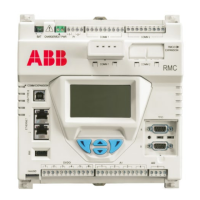2105552MNAE | RMC-100 | 195
Figure 8-37: Restart using factory configuration
8.6 Change the clock
When applications are instantiated on the RMC, a change to the clock for daylight savings time, or
time drift of the instantiated applications, can affect the time on log period entries. A clock change
must preserve the integrity of accounting audit trails. Follow the guidelines for clock changes
according to Table 8-4
.
Table 8-4: Types of clock changes
crossing an hour
boundary
The clock does not change for the next log period entry.
Example: If present time is 4:15 p.m. and the clock changes to 4:05 p.m. of the
same day, the entry reflects accumulated averages over a 70-minute time-
period (15 minutes plus 55 minutes).
change crossing
an hour
boundary
This forces a log period entry for the portion of the hour that accumulated since
last hourly entry. The RMC then advances to the newly-defined data flow record
boundary and maintains the day’s data in the newly defined boundary.
Example: If present time is 4:55 p.m. and clock changes to 5:05 p.m. of the
same day, the entry reflects only a 55-minute average accumulation. Then a
new flow record is written based on a 55-minute accumulation.
change crossing
an hour
boundary
The hourly entry includes the part of the hour that accumulated since the last
hourly entry. This is the same as it would be for a forward clock change that
crosses an hourly boundary. The RMC advances to a new day’s data flow record
and maintains the balance of the day’s data in the new record.
Example: If present time is 5:05 p.m. and clock is changed to 4:55 p.m. of the
same day, the log period record entry reflects only a 5-minute average
accumulation. Then a new flow record has a 60-minute accumulation.
Make time changes in the Date/Time field on the PCCU Station Setup tab.

